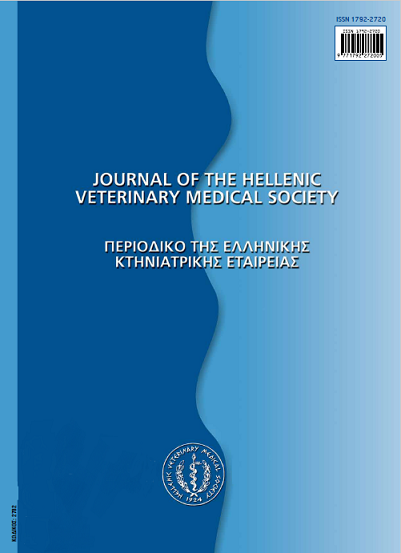Αποτροπή του κίνδυνου διασποράς εγκεφαλικών τεμαχιδίων στο αίμα και το σφάγιο κατά την αναισθητοποίηση των βοοειδών: εναλλακτική μέθοδος αναισθητοποίησης

Περίληψη
Κατά την τρέχουσα πρακτική αναισθητοποίησηςτων βοοειδών με το πιστόλι με διατρητική ράβδο, η είσοδος του εμβόλου στην κρανιακή κοιλότητα προκαλεί μαζική καταστροφή της εγκεφαλικής ουσίας. Μέσω της φλεβικής κυκλοφορίας υπάρχει κίνδυνος μεταφοράς τεμαχιδίων της εγκεφαλικής ουσίας και πρόκληση μόλυνσης του αίματος, των πνευμόνων και της καρδιάς απότον παράγοντα της σπογγιόμορφης εγκεφαλοπάθειας των βοοειδών (ΣΕΒ). Το Κεντρικό Νευρικό Σύστημα (ΚΝΣ) συγκεντρώνει όλη σχεδόν τη μολυσματικότητα στα βοοειδή, τα οποία έχουν προσβληθεί από τη ΣΕΒ. Οι εγκεκριμένες ταχείες δοκιμές διάγνωσης μετά τη σφαγή δεν είναι ικανές να εξακριβώσουν ζώα μολυσμένα από ΣΕΒ κατά το αρχικό διάστημα της επώασης. Έτσι, είναι πιθανό όταν ένα ζώο αναισθητοποιηθεί με μία μέθοδο η οποία παράγει έμβολα να εμφανίσει έμβολα μολυσμένα από τον παράγοντα της ΣΕΒ, διεσπαρμένα μέσω της φλεβικής κυκλοφορίας, στους πνεύμονες και την καρδιά, παρ' όλο το αρνητικό αποτέλεσμα της ταχείας δοκιμής διάγνωσης. Αυτός ο κίνδυνος της μόλυνσης έχει αποδειχθεί σε αρκετές επιστημονικές εργασίες. Η διαβάθμιση τωνμεθόδων αναισθητοποίησης κατά σειρά μειουμένου βαθμού κίνδυνουγια πρόκληση μόλυνσης είναι: 1. Συσκευή πεπιεσμένου αέρα που εγχέει αέρα. 2. Συσκευή πεπιεσμένου αέρα που δεν εγχέει αέρα.3. Συσκευή με διατρητική ράβδο και pithing. 4. Συσκευή με διατρητική ράβδο χωρίς pithing. Αμελητέος ή κανένας κίνδυνος μπορεί να αναμένεται από: Πλήγμα στο κρανίο (μη διατρητική μέθοδος) και την ηλεκτροθανάτωση (ηλεκτροπληξία). Προς το παρόν η ηλεκτροπληξία εφαρμόζεται στην πράξη σε ελάχιστα μόνο σφαγεία της ΕΕ. Από το καλοκαίρι του έτους 2001 λειτουργεί η πρώτη συσκευή ηλεκτροπληξίας στην ηπειρωτική Ευρώπη. Περιγράφονται δυο συστήματα ηλεκτροπληξίας, τα οποία καλύπτουν τις απαιτήσεις της νομοθεσίας (Γερμανικής και Ηνωμένου Βασιλείου) περί προστασίας των ζώων κατά τη σφαγή. Η αντικατάσταση της διατρητικής μεθόδου αναισθητοποίησης με την ηλεκτροπληξία, σε περιοχές όπου απαντάται η ΣΕΒ, αποτρέπει τον κίνδυνο της διασποράς των εγκεφαλικών τεμαχιδίων στο αίμα και το σφάγιο.
Λεπτομέρειες άρθρου
- Πώς να δημιουργήσετε Αναφορές
-
RAMANTANIS (Σ. ΡΑΜΑΝΤΑΝΗΣ) S. (2017). Αποτροπή του κίνδυνου διασποράς εγκεφαλικών τεμαχιδίων στο αίμα και το σφάγιο κατά την αναισθητοποίηση των βοοειδών: εναλλακτική μέθοδος αναισθητοποίησης. Περιοδικό της Ελληνικής Κτηνιατρικής Εταιρείας, 54(3), 230–235. https://doi.org/10.12681/jhvms.15263
- Τεύχος
- Τόμ. 54 Αρ. 3 (2003)
- Ενότητα
- Review Articles
Οι συγγραφείς των άρθρων που δημοσιεύονται στο περιοδικό διατηρούν τα δικαιώματα πνευματικής ιδιοκτησίας επί των άρθρων τους, δίνοντας στο περιοδικό το δικαίωμα της πρώτης δημοσίευσης.
Άρθρα που δημοσιεύονται στο περιοδικό διατίθενται με άδεια Creative Commons 4.0 Non Commercial και σύμφωνα με την άδεια μπορούν να χρησιμοποιούνται ελεύθερα, με αναφορά στο/στη συγγραφέα και στην πρώτη δημοσίευση για μη κερδοσκοπικούς σκοπούς.
Οι συγγραφείς μπορούν να καταθέσουν το άρθρο σε ιδρυματικό ή άλλο αποθετήριο ή/και να το δημοσιεύσουν σε άλλη έκδοση, με υποχρεωτική την αναφορά πρώτης δημοσίευσης στο J Hellenic Vet Med Soc
Οι συγγραφείς ενθαρρύνονται να καταθέσουν σε αποθετήριο ή να δημοσιεύσουν την εργασία τους στο διαδίκτυο πριν ή κατά τη διαδικασία υποβολής και αξιολόγησής της.


